1. Manual discovery with Google
By far the most popular approach to finding suitable sites and contacts is googling related search terms and then delving into the results. We also take time to explore image, video, news and map results—you never know what you might find!
The below example highlights a list of articles I would investigate. From this list, I would also see if the associated author looks like a suitable recipient for my music-centric content.
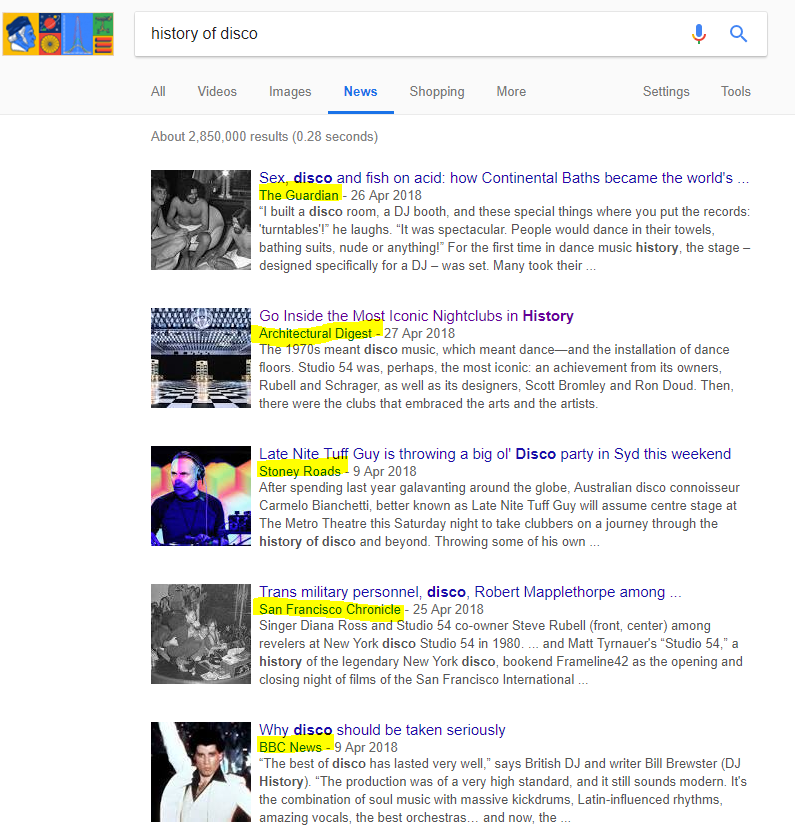
If an article does look suitable, I will add the domain name, relevant article URL and the contact’s name to my list, followed by contact details. Alternatively, I would add this information to a software platform, such as BuzzStream.
Pro tip: you can refine your search in the settings via Google tools. Through this, you can define a date range, which will allow you to view a list of the latest articles on the topic or sites in a specific country.
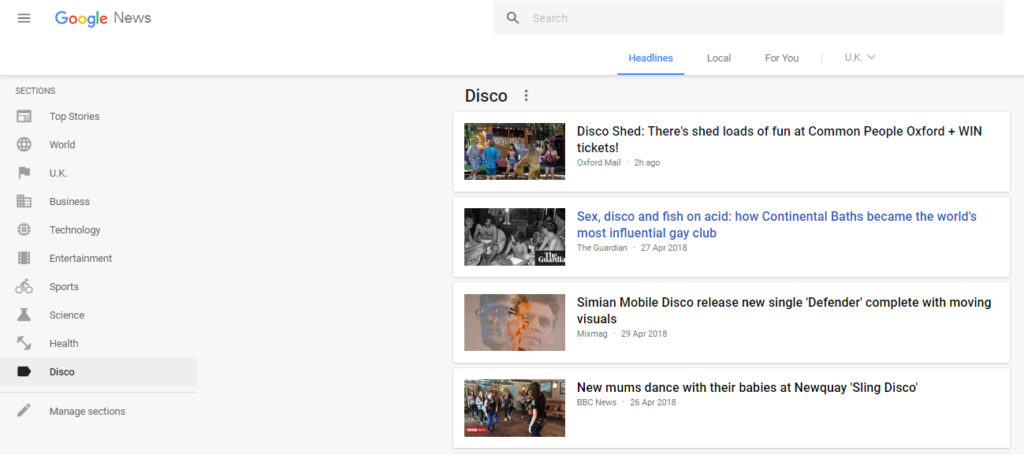
Be sure to visit Google News to ensure you’ve looked into all the latest related headlines, too.
If the asset you’ve produced is live on a site already and contains an image, do an image search using Google to see if it has naturally been picked up elsewhere. From there, you might find further opportunities to reach out and ask for the image to be credited with a link back to the original piece of content if it’s not already doing so.
How to:
Right click on an image -> click ‘Search Google for Image’.
Use Google advanced search operators to narrow down your manual search.
Some of my favourite operators are:
- Find related websites by typing “related:” in front of a website’s domain: related:builtvisible.com
- Find out if a website is covering a specific topic or shares certain formats through site search: site:time.com infographic
Helpful resources:
Google: Refine web searches
Moz: Mastering Google Search Operators
Beyond: Google advanced search
2. Scrape pages
Using a selection of tools, you can quickly extract key information from web pages. This is called scraping and it ultimately speeds up the prospecting process.
Required tools
gInfinity – infinite scroll for Google search results (otherwise known as Search Engine Results Pages, or SERPs)
Google SERPs Extractor or Linkclump – helps you extract a big list with ease
Three-step method
1. Pop your search query into the big G (Google)

2. Scrape the results and extract a list using gInifity and Google SERPS Extractor/ Linkclump
Tip: you will need to tweak the settings on Linkclump in order for it to extract correctly. We use the following:
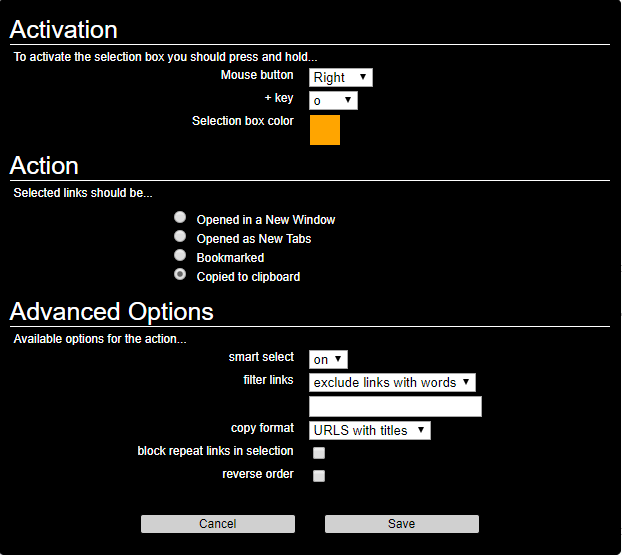
Then paste your list into Excel. It should look something like this:
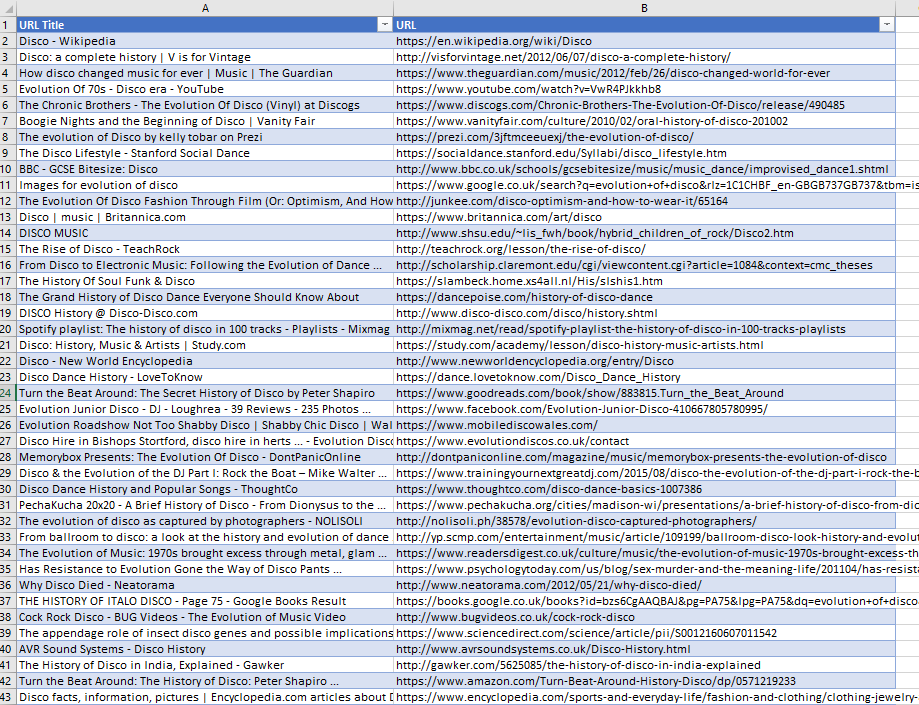
3. Analyse and prune the extracted list
This will identify which articles (and therefore which authors and publications) will make it to your outreach list.
To speed up the analysis process, I recommend fetching those SEO metrics I mentioned in the previous post, for example, Majestic’s Trust Flow. With the addition of SEO metrics such as Trust Flow you will be able to whittle away any untrustworthy websites, ensuring that time is being spent on websites worth targeting with your content.
At Builtvisible, we have a selection of platforms at our disposal, however, for this purpose, I would recommend using URL Profiler.
How to use URL Profiler:
- Paste the list of URLs from the Excel spreadsheet into URL Profiler
- Select the metrics you’re interested in—in this case Trust Flow, which masquerades as a checkbox named ‘Majestic’.
- Wait for the magic to happen
You’ll need to have a paid Majestic account and ensure the Majestic API is hooked up to work with URL Profiler. More informa- tion about how to authorise URL Profiler’s access to Majestic’s API found.
After a bit of a tidy up, you should then be left with something like this:
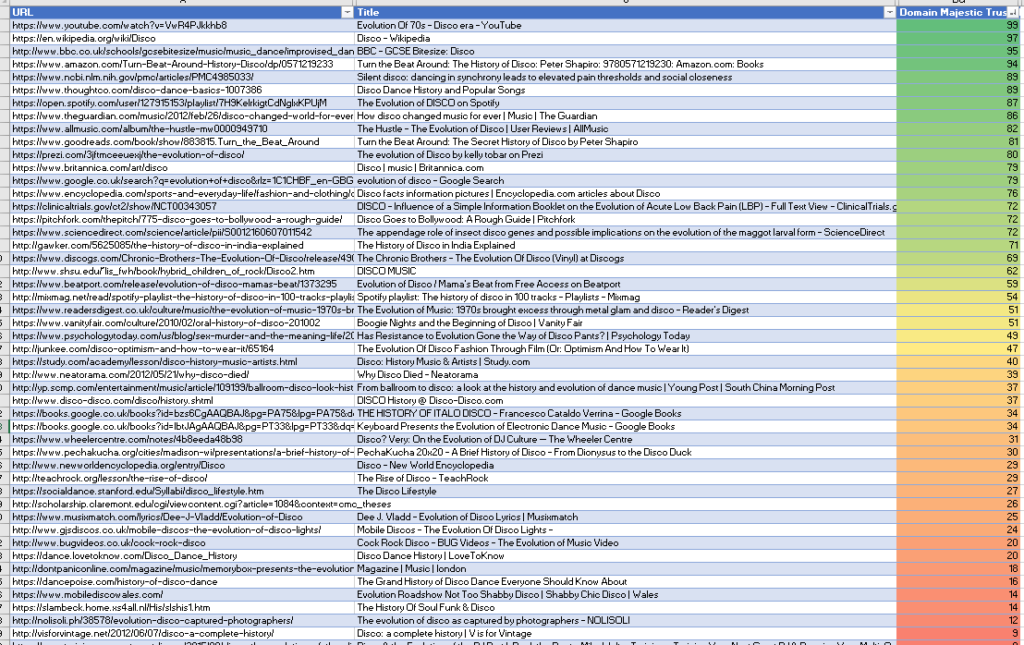
As you can see, I’ve chosen to sort my list by Trust Flow (largest to smallest) and have applied some cheeky conditional formatting—this makes it easier for me to see which articles I definitely want to look into, versus those I want to discard.
How to:
You can apply colour scale formatting in Excel via the conditional formatting drop down button and select the colour scale you’re after. More on conditional formatting in Excel here and Google Sheets here.
3. Discover similar or related websites
For this, we use Google Chrome’s SimilarSites extension, SimilarSites or Right Relevance.
Personally, I like to use the extension as opposed to the search function as I think it’s more efficient, but it’s up to you!
How to use the SimilarSites extension:
- Let’s say you’ve hit upon a website that is highly relevant to what you’re outreaching
- Click on the SimilarSites extension button
- A neat list of similar websites to investigate will present itself
Additionally, you can use Right Relevance to discover similar articles and websites. You can then analyse these and hopefully add them to your outreach list.
You can even geolocate, specify video only and sort by relevance or time.
Right Relevance also spits out a list of relevant influencers and trending conversations which could offer up even more outreach opportunity.
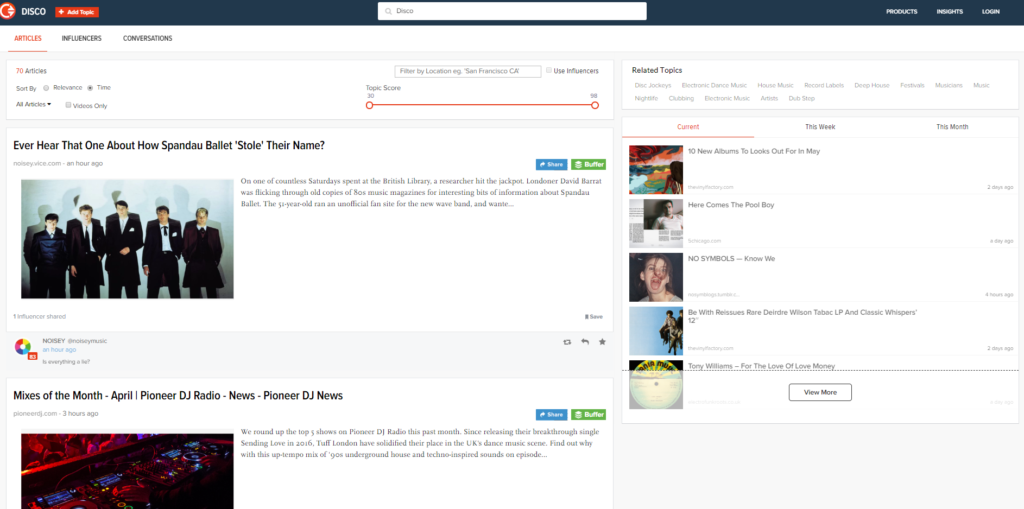
4. Use other paid tools
Buzzsumo, Ahrefs and Majestic can also be extremely helpful when it comes to building your outreach list:
Helping you create & amplify content. View most shared content & influencers for any topic or site. Content strategy, outreach & competitive research.
BuzzSumo
BuzzSumo offers up a whole host of valuable insights and features to help you build out your outreach list.
The ‘Content Research’ tab’s ‘Content Analyzer’ feature is my first port of call. Drop in a topic, keyword or domain and within seconds you’ll have an overview of the content that is most engaged with and shared.
You have the ability to filter the results by date, content type, language, country and word count, to name but a few!
Once you have your list, simply export as a CSV and start refining the results for relevancy.
The ‘Influencers’ tab allows you to search for influencers who may (or may not) be suitable to outreach to. Here you’re able to filter by influencer type, e.g. blogger or journalist, as well as by country.
For the purposes of building an outreach list, I feel the aforementioned features are the most important when it comes to BuzzSumo, but its features are extensive, so I would recommend anyone who hasn’t tried it out to give it a go!
Ahrefs
Like BuzzSumo, Ahrefs offers up its own version of the most shared content via the ‘Content Explorer’ feature and is in fact considered to be the best alternative to BuzzSumo. Again, just like BuzzSumo, you have multiple filter-by options, though Ahrefs additionally offers the user the ability to filter results by estimated monthly organic traffic as a nice value-add.
I also particularly like that you can specify where your chosen topic should feature, i.e. in the title, in the content or everywhere. You’ll find this feature next to the search bar:
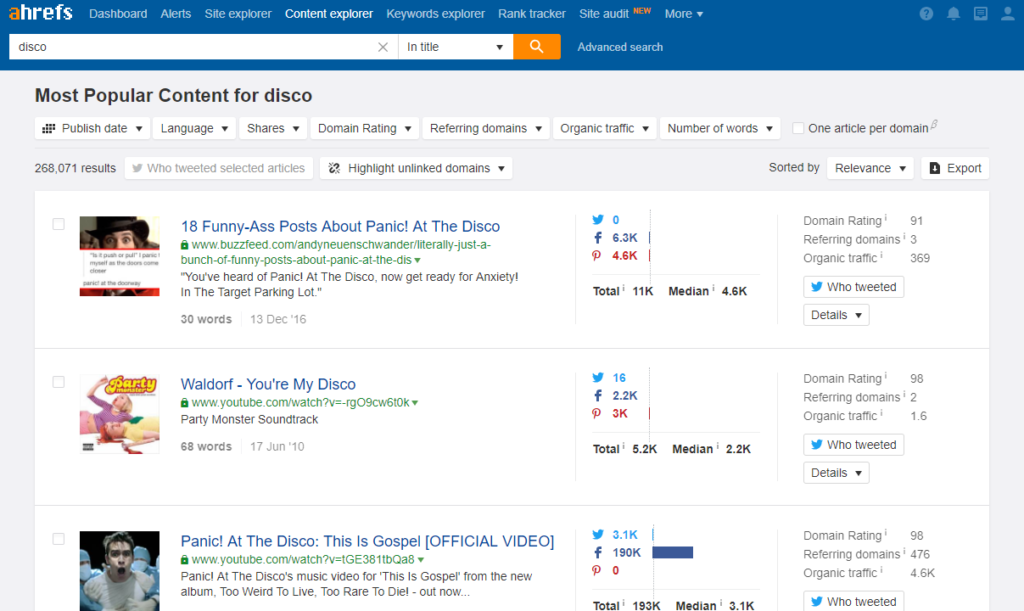
Ahref ’s ‘Site Explorer’ is also invaluable if you’ve come across an article that is very similar to what you’re intending to promote.
Pop the URL of the similar article into the search bar and you’ll get an overview of the links that page has already acquired, which may open up even more outreach opportunities as the page may have built links from websites you’ve yet to come across.
Majestic
This is also a great tool to find out what links a piece of content has accrued. Simply slot in the URL of a similar article you’ve come across and check out its backlink profile
Dig into that backlink profile to see if there are more websites that you can add to your outreach list.
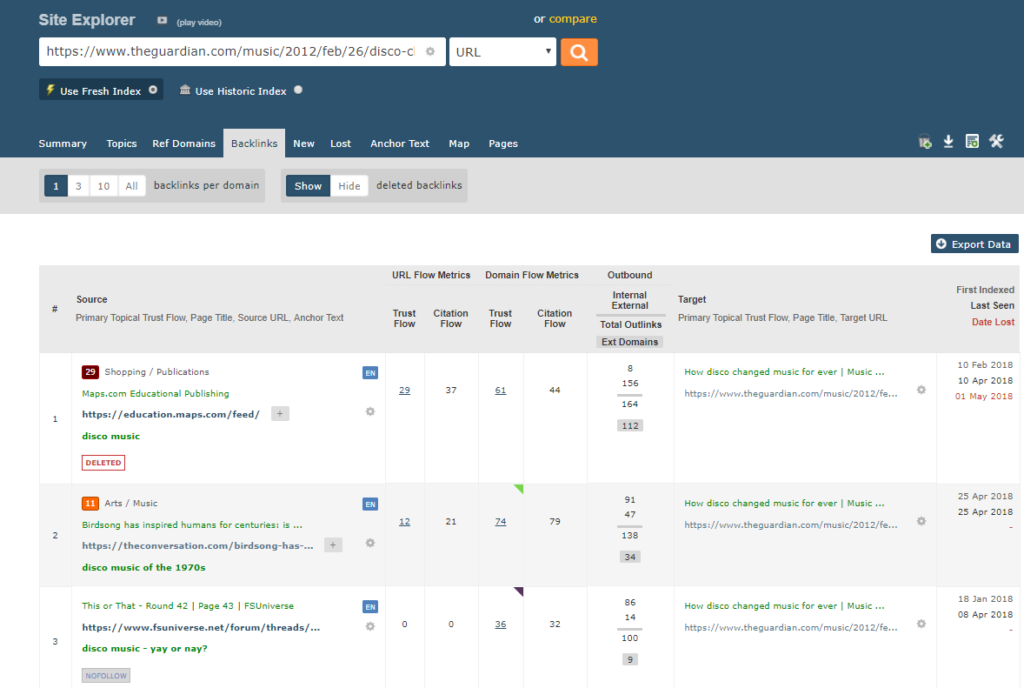
For the non-SEOs out there, a backlink profile is simply a list of all external websites linking to the article that you’re interested in.
5. It’s not the end of the world if you don’t have access to paid tools
This is because social platforms can also be valuable when building an outreach list.
Twitter is usually my starting point, as it’s an almost instant way to grab an overview of relevant trending conversations, key influencers and outreach targets. Type your query into the search bar and see what comes back. Don’t forget about Twitter’s advanced search filter option—it’ll really help you refine your search.
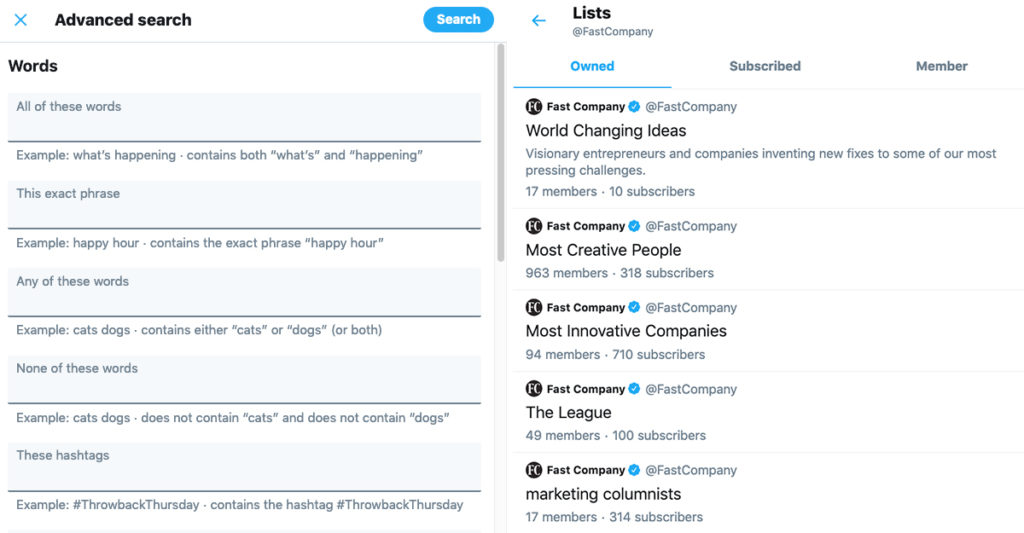
If you’ve got a publication wishlist, I suggest checking each publication’s Twitter accounts to see if any have public lists. If yes, there could be a convenient staff list worth digging into.
Top tip #1
Follow the hashtag ‘#journorequest’. There may be one key journalist looking for the very piece of content or story you’re working on. In a similar way, you can search for key publications on LinkedIn and use related people to expand your list even more.
Instagram, Facebook and Twitter are also really useful because sometimes your outreach targets leave helpful tips about getting in touch. For example, some journalists explain they prefer to be contacted with particular subject lines or at certain times, while others highlight pet peeves to avoid.
Top tip #2
Get the Skrapp Chrome extension to export page results and, in some cases, find email addresses too.
Top tip #3
If you’ve not heard back from a must-have-coverage-from target, perhaps they are on holiday? Use Instagram to validate and schedule a follow-up email accordingly.
If you have existing outreach lists from past projects, then make use of them! See if any of those outreach targets are applicable to the asset or story you’re looking to share.
Now that you’ve built out what is hopefully a robust and relevant list of publications and author names for your content, it’s time to organise and prioritise your outreach list. More on that in part 4 of this blog series.
